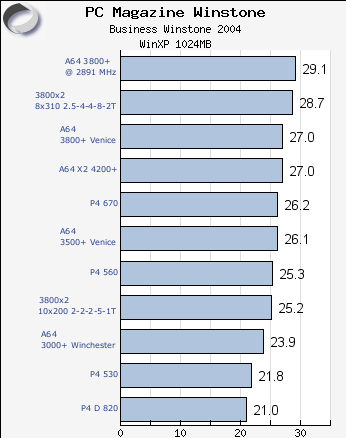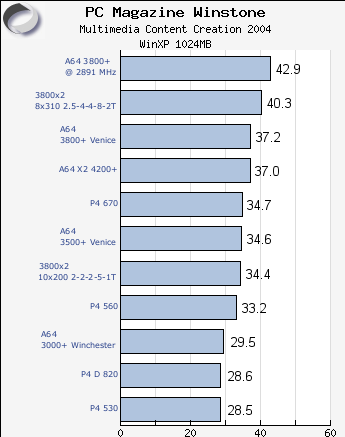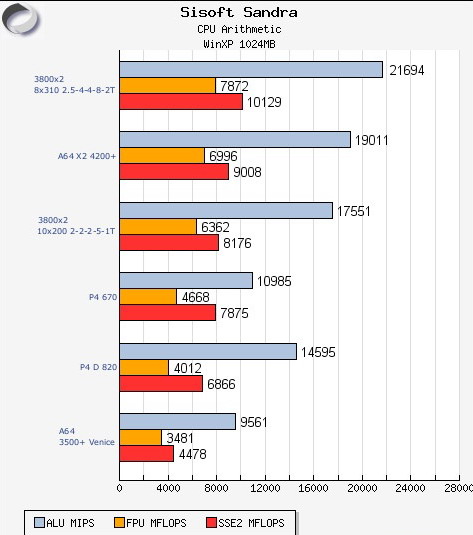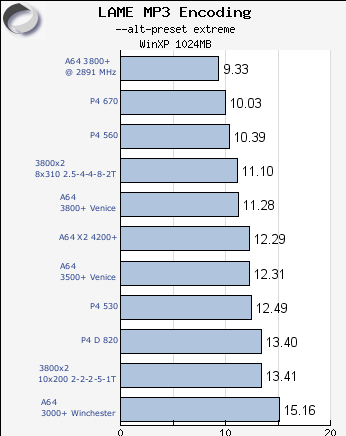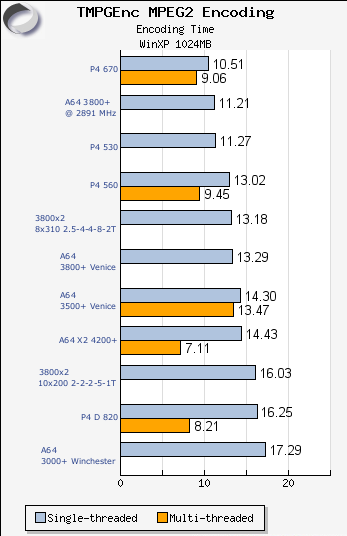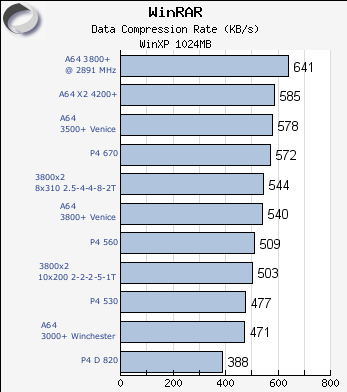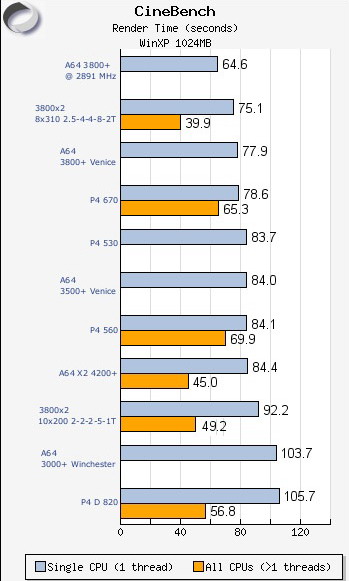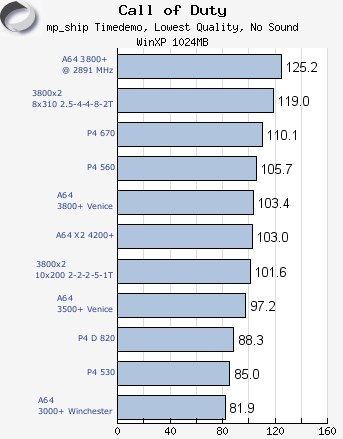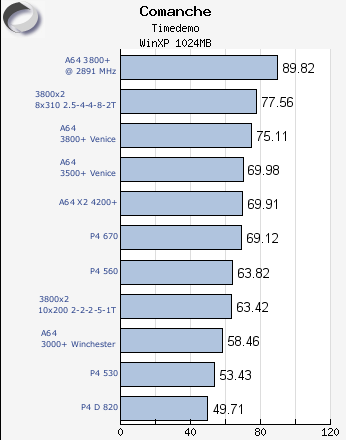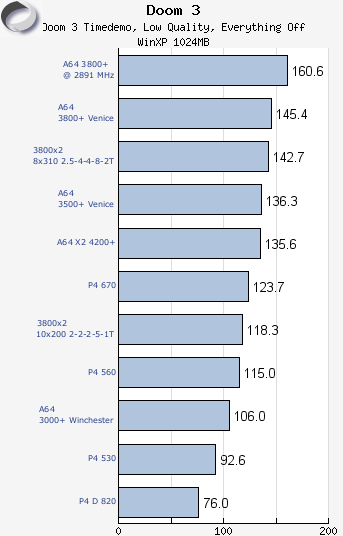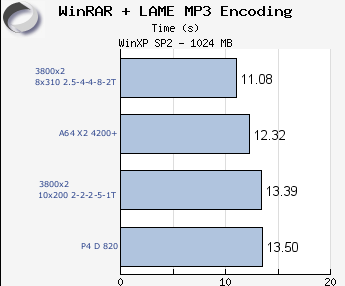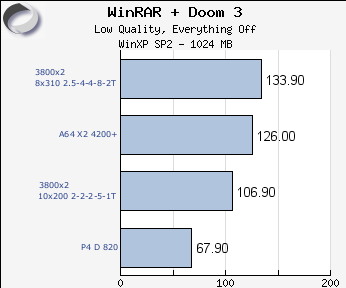3800+ X2 REVIEW AMD ATHLON X2 64 3800+ BENCHMARK OVERCLOCKING TEST
![]()
|
|
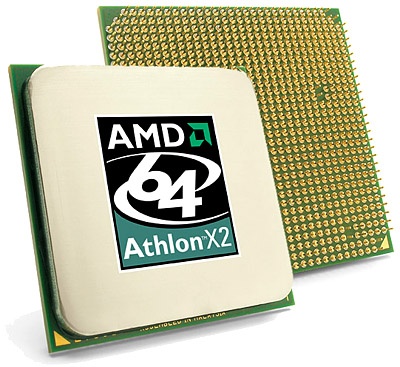 |
||||||||||||
| Posted:2006-05-06 By hardware review Number of View:11274 |
|||||||||||||
By :hardware review Posted:2006-05-06
3800+ X2 Review AMD Athlon x2 64 3800+benchmark Overclocking testIntel and AMD are both touting the advantages of dual core processors. Here at Neoseeker, so far we have taken a look at Intel's 820D and AMD's 4200 x2. Intel's and AMD's approaches are somewhat different - currently AMD has a technically superior design for cache coherency checking; Intel still has to perform all such functions across its FSB. Really, the Intel approach is nothing more than putting two cores on one die and marrying them at the FSB; whereas the AMD approach is more sophisticated as it uses a crossbar switch between the processor cores, the memory busses, and the Hypertransport links; not to mention an out of band communications link for cache coherency checks.
Until recently, there was a huge price differential between Intel and AMD dual core processors - with the Intel 820 now hovering around $250 and the AMD 3800+ around $380 it was time we took another look at some dual core goodness. With AMD's 90nm process and better thermal characteristics, the 3800+ promises to be a good overclocker - and ofcourse we tried to overclock it to see how much extra bang for the buck you can get if you are adventerous. Testing the Athlon x2 64 3800+Our test system consisted of the following hardware:
Software used during testing consisted of the following:
The Athlon 3800+ x2 is AMD's answer to the lower cost Intel 820 D dual core processor. AMD is still pricing the 3800x2 at a significant premium over the 820D, assuming that the price differential will be justified by the performance differential - as well as the lower availability of dual core compatible motherboards for the 820D. Intel on the other hand is betting that people would rather pay less for an 820D processor than for a faster AMD 3800x2 processor; and it no doubt is still counting on name brand recognition, as some people will still only buy Intel. Looking at it from an outsiders point of view, once you consider the cost of 820D + 945 or 955 based motherboard + DDR2 memory vs. 3800x2 + almost any s939 based motherboard + DDR memory there is little if any price differential; so what it boils down to is which platform you prefer due to either performance or personal choice. Busines Winstone X2 3800+ benchmarkWhile we are showing some single core results in the charts, we will be concentrating on comparing dual core performance. Here, the 3800x2 does quite well - at stock settings it beats the 820D by 4.2 Business Winstone points, or approximately 20%. The 4200x2 does of course beat the 3800x2 by 1.8 points... but look at the 3800x2 fly when overclocked. Running at 2.48GHz, it is 1.7 points ahead of the 4200x2 and 7.7 points ahead of the 820D.
Content Creation X2 3800+ benchmarkWe have a similar situation in the Content Creation benchmark. The stock 3800x2 beats the 820D by 5.8 points; the 4200x2 beats the 3800x2 by 2.6 points... but the overclocked 2.48GHz 3800x2 beats the 820D by a full 11.7 points, and the 4200x2 by 3.3 points
Sandra CPU Test X2 3800+ benchmarkThere is no other way of saying it than the 3800x2 at stock speeds clobbers the 820D for the Sandra CPU tests. It's not even close. As we would expect, the 4200x2 beats the 3800x2, but look at the scores the overclocked 3800x2 gets!
Sandra Memory Test X2 3800+ benchmarkThe Athlon 64's always had excellent memory performance, and this chart merely proves it yet again. The stock 3800x2 beats the 820D by almost 320MB/sec, and is in turn beaten by the 4200x2 by 450MB/sec - but look at the scores from the overclocked 3800x2! Yes, the single core overclocked 3800+ got the best results here, but we are comparing dual core chips for this review
RightMark Read X2 3800+ benchmarkWe get the same story with Rightmark as we got with Sandra. The Athlon's simply dominate in memory performance - there is no visible advantage to using DDR2 vs. DDR here.
RightMark Write X2 3800+ benchmark
Encoding X2 3800+ benchmark
Non-multi threaded encoding is dominated by clock speed, and the faster single core Intel and AMD chips clearly dominate the chart for Lame. Of the dual core devices, the 3800x2 is very narrowly beaten by the 820D, and both are beaten by the 4200x2 and especially the overclocked 3800x2.
TMPGEnc is one of the few places where Hyperthreading shows a noticeable improvement for Intel processors versus single core processors; however dual core still wins. Unfortunately we had problems with our TMPGEnc encoder and are missing 3800x2 multi-threaded results at this time, however the 4200x2 results show a better than linear scaling for the 4200x2 - so given that the single threaded test shows the 3800x2 to be a bit faster than the 820D, it looks like the multi-threaded test would also have beat the 820D by a small margin.
Compression X2 3800+ benchmarkWinRAR likes a combination of raw processor speed and memory bandwidth, and is not multi-threaded at this time. The 3800x2 significantly outperforms the 820D and is in turn outperformed by the 4200x2.
Cinebench X2 3800+ benchmarkCinebench is an excellent application for testing multi-core performance as it is CPU bound and scales well with the additional core. The stock 3800x2 handily beats the 820D, and surprisingly even beats the 4200x2 in the multithreaded test. The overclocked 3800x2 dominates the dual core results, however the lower than expected change in performance from the stock results suggests that with two cores running at 2.48GHz the system may have been starved for memory bandwidth.
POVRay 3.7b4 X2 3800+ benchmarkThe multi-threaded versions of the test show the 820D beating both the 3800x2 and 4200x2, and in turn being beaten by the overclocked 3800x2.
Call Of Duty X2 3800+ benchmarkIt should not be a surprise that for single threaded games the performance is limited by core design and speed, and that the Athlon performs better than the Pentiums. The 820D is thoroughly trounced here.
Comanche 4 X2 3800+ benchmarkGames are just not the 820D's forte. AMD again wins by quite some margins
Doom 3 X2 3800+ benchmarkDoom 3 has always done extremely well with Athlons; and here the 820 D is thoroughly beaten. I won't even give you percentages; just look at the chart of fps rates.
X2 3800+ OverclockingThe 3800x2 overclocked suprisingly well; I am quite certain that I would have been able to push it further with a better cooling solution - and I may try doing just that in a few weeks. For the best performance I was able to achieve, I ran the processor at 1.5V, the memory at 2.7V with 2.5-4-4-8-2T timings. I reduced the HT multiplier to 3x, and increased the FSB clock to 310MHz with a multiplier of 8. This resulted in a 2480MHz core clock speed, 930MHz HT speed, and 310MHz (DDR620) memory speed. The much higher memory bandwidth provided by these settings resulted in outstanding performance, with some of the highest results we've ever seen. We did have to use an outside fan to move additional air over the processor's OEM heatsink and fan to keep the system stable, however if I were building an x2 based system, I would probably use a high efficiency cooler like the Gigabyte G-Power as it would potentially allow for even greater overclocking headroom. If you wanted to overclock your system, here are some hints so you can do so as safely as possible:
Showing Dual Core BenefitsThere are real benefits to running two or more cores. Business users can already benefit from multiple cores - it will "smooth" out their multi-tasking experience, for all intents and purposes, two cpu hogging applications can run at once as smoothly as one could before. High speed DVD burning is just one example of something you could run in the background without fearing bad burns. Graphics rendering can also immediately show great benefit from multiple cores - and so can video encoding with the right software. But to be able to show you evidence of these benefits, we ran more than one application simultaneously to see whether the second core would help offload some of the work. We ran WinRAR in combination with LAME encoding for one test. At 12x200 (stock speed) WinRAR's performance did drop from 503 to 459, but the LAME encoding was actually a hair faster at 13:39 instead of 13:41 on the stand-alone test - so basically the two very CPU bound applications ran at full speed! At 8x310 (overclocked speed) WinRAR stayed at 544 - same as when running alone; and LAME also scored identically to running alone! I believe the slightly lower score at the stock speed was due to contention for memory, but the overclocked memory bus made sufficient bandwidth available for both programs to run at full speed.
We also ran WinRAR with Doom3 for a second series of tests. WinRAR + Doom3 did show a slight slowdown - at stock speeds the frame rate dropped to 106.9 from 118.3, and at overclocked speeds it dropped to 133.9 from 142.7 - but still, this is very little impact for running two very CPU bound applications at once!
Conclusion The 3800x2 ROCKS. The gaming performance shows that even when only using one of the cores you can still get very high framerates in popular games; and once multi-threaded games come out - which may take years due to the need to completely re-write the engines to take full advantage of multiple cores - gaming performance will get even better. The Cinebench and POVRay 3.7b4 results show that multi-threaded applications can benefit greatly from the second core; for applications that are not memory bound (ie they don't spend most of their time reading/writing from memory) you can actually closely approach the theoretical maximum of twice the performance of a single core. Business users who run several applications at once will immediately benefit from a smoother running system, one that will not drop to its knees under a heavy load - no more worrying about your DVD burning being affected by foreground applications. Given the current directions of the computer and console industries, you can bet that in the future all major software houses will be re-writing their applications and game engines to fully exploit multiple cores by writing heavily multi-threaded code; and when that happens, just watch the performance fly on multi-core systems. Highly Recommended. Editor's Choice.
we would be happy to answer for your question . if you have suggestion or comment
regarding this review our support would be glad to help just join our forum and ask u will get the best answer
to discuss check our forum section :-) RATE THIS REVIEW | |||||||||||||
![]()

3800+ X2 Review AMD Athlon x2 64 3800+ benchmark Overclocking test
3800+ X2 Review AMD Athlon x2 64 3800+ benchmark Overclocking test


7600gt review
7600gt is the middle card range.
We already benchmarked this video card and found that ...

 geforce 8800gtx and 8800gts
geforce 8800gtx and 8800gts  Xtreview software download Section
Xtreview software download Section  AMD TURION 64 X2 REVIEW
AMD TURION 64 X2 REVIEW  INTEL PENTIUM D 920 , INTEL PENTIUM D 930
INTEL PENTIUM D 920 , INTEL PENTIUM D 930  6800XT REVIEW
6800XT REVIEW  computer hardware REVIEW
computer hardware REVIEW  INTEL CONROE CORE DUO 2 REVIEW VS AMD AM2
INTEL CONROE CORE DUO 2 REVIEW VS AMD AM2  INTEL PENTIUM D 805 INTEL D805
INTEL PENTIUM D 805 INTEL D805  Free desktop wallpaper
Free desktop wallpaper  online fighting game
online fighting game  Xtreview price comparison center
Xtreview price comparison center 

- The new version of GPU-Z finally kills the belief in the miracle of Vega transformation
- The motherboard manufacturer confirms the characteristics of the processors Coffee Lake
- We are looking for copper coolers on NVIDIA Volta computing accelerators
- Unofficially about Intels plans to release 300-series chipset
- The Japanese representation of AMD offered monetary compensation to the first buyers of Ryzen Threadripper
- This year will not be released more than 45 million motherboards
- TSMC denies the presentation of charges from the antimonopoly authorities
- Radeon RX Vega 64 at frequencies 1802-1000 MHz updated the record GPUPI 1B
- AMD itself would like to believe that mobile processors Ryzen have already been released
- AMD Vega 20 will find application in accelerating computations
- Pre-orders for new iPhone start next week
- Radeon RX Vega 57, 58 and 59: the wonders of transformation
- ASML starts commercial delivery of EUV-scanners
- The older Skylake processors with a free multiplier are removed from production
- Meizu will release Android-smartphone based on Helio P40
- AMD Bristol Ridge processors are also available in American retail
- The fate of Toshiba Memory can be solved to the next environment
- duo GeForce GTX 1080 Ti in GPUPI 1B at frequencies of 2480-10320 MHz
- New Kentsfield overclocking record up to 5204 MHz
- Lenovo released Android-smartphone K8



computer news computer parts review Old Forum Downloads New Forum Login Join Articles terms Hardware blog Sitemap Get Freebies


